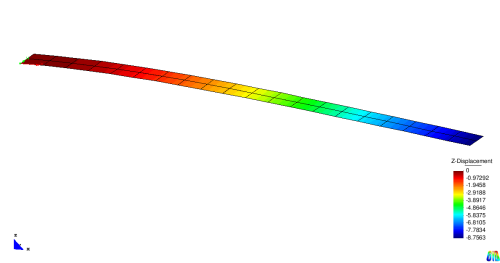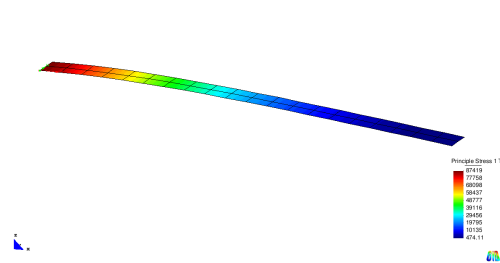Users:General FEM Analysis/Analyses Reference/Buckling
(Created page with ' info to be added') |
|||
| Line 1: | Line 1: | ||
| − | + | [[Category: Users:General FEM]] | |
| + | |||
| + | |||
| + | == General Description == | ||
| + | |||
| + | This analysis performs a ''linear'' estimation of the buckling load factor. To this purpose the system stiffness '''K''' is considered to consist of two parts, the elastic stiffness '''K'''''el'' | ||
| + | |||
| + | |||
| + | [[Users:General FEM Analysis/Analyses Reference/Static Nonlinear|static nonlinear analysis]] | ||
| + | |||
| + | |||
| + | |||
| + | === Structure of Equation System === | ||
| + | |||
| + | The linear static analysis solves the problem '''K'''*'''U'''='''F''', with the linear stiffness matrix '''K''', the unknown displacement fields '''U''' and the right hand side vectors '''F'''. This system of equations is solved for the unknown displacements by a linear solver. In general, linear solvers may be separated in iterative and direct solvers. Direct solvers transform the stiffness matrix '''K''' into an upper diagonal matrix. The displacement field follow by a back substitution with the respective right hand side vector. These back substitution requires only small numerical effort which makes direct solvers very attractive if a couple of displacement fields have to be computed. | ||
| + | |||
| + | |||
| + | == Input Parameters == | ||
| + | |||
| + | === Parameter Description === | ||
| + | |||
| + | {| border="1" cellpadding="3" cellspacing="0" | ||
| + | |colspan="3" style="background:#efefef;"| Compulsory Parameters | ||
| + | |- | ||
| + | !Parameter | ||
| + | !Values, Default(*) | ||
| + | !Description | ||
| + | |- | ||
| + | !SOLVER | ||
| + | |PC-SOLVER ''int'' | ||
| + | |Linking to a linear solver (direct or iterative) | ||
| + | |- | ||
| + | !OUTPUT | ||
| + | |PC-OUT ''int'' | ||
| + | |Linking to [[Users:General FEM Analysis/Data Output|output objects]] (specifies the type of output format, e.g. GiD) | ||
| + | |- | ||
| + | !COMPCASE | ||
| + | |LD-COM ''int'' | ||
| + | |Linking to computation case objects which specify the boundary conditions (loading and supports) | ||
| + | |- | ||
| + | !DOMAIN | ||
| + | |EL-DOMAIN ''int'' | ||
| + | |Linking to the domain the analysis should work on | ||
| + | |} | ||
| + | |||
| + | === Example of a Complete Input Block === | ||
| + | <pre> | ||
| + | PC-ANALYSIS 1: STA_GEO_LIN | ||
| + | SOLVER = PC-SOLVER 5 | ||
| + | OUTPUT = PC-OUT 1 | ||
| + | COMPCASE = LD-COM 1,2,3 | ||
| + | DOMAIN = EL-DOMAIN 1 | ||
| + | </pre> | ||
| + | |||
| + | == A Full Example == | ||
| + | |||
| + | The following example describes a simple cantilever problem discretized by [[Users:General FEM Analysis/Elements Reference/Shell8|SHELL8]] elements. The respective input file can be found here: | ||
| + | |||
| + | {{PathToBenchmarkExamples}}elements/shell8_quad_lin_canti_I/shell8_canti_2x20_elem_load.dat | ||
| + | |||
| + | |||
| + | The problem computes three computation cases (dead load, snow load and pressure load). The [[Users:General FEM Analysis/BCs Reference|boundary conditions]] are visualized by the figure below. | ||
| + | {| | ||
| + | |[[File:Shell8_canti_org_geom_01.png|frame|up|Simple cantilever problem using SHELL8 elements]] | ||
| + | |} | ||
| + | |||
| + | The basic goal of each linear static analysis is the computation of the displacement field. For load case 1 this result is depicted in the figure below, whereas the deformation in z-direction is additionally visualized by the color plot. | ||
| + | {| | ||
| + | |[[File:Shell8_canti_def_geo_disp.png|frame|up|Displacement of cantilever problem]] | ||
| + | |} | ||
| + | It can be seen that the support region does not show any deformation whereas the tip region deforms by a value of 8.76. | ||
| + | |||
| + | Often the stress distribution is visualized by color plots. Shell structures require the specification of the layer on which the stresses are computed. The picture below shows the first principle stress on the top of the cantilever. | ||
| + | {| | ||
| + | |[[File:Shell8_canti_def_geo_stress1.png|frame|up|First principle stress of cantilever problem (top layer)]] | ||
| + | |} | ||
| + | It can be seen that the stresses show maximum values at the support region of the cantilever. At the tip they are nearly zero. In contrast to analytical results the stresses are not exactly zero in numerical models. The reason is the stress computation at the Gauss points. These points are situated inside the elements and not exactly at the tip of the cantilever. | ||
Revision as of 09:28, 28 April 2011
Contents |
General Description
This analysis performs a linear estimation of the buckling load factor. To this purpose the system stiffness K is considered to consist of two parts, the elastic stiffness Kel
Structure of Equation System
The linear static analysis solves the problem K*U=F, with the linear stiffness matrix K, the unknown displacement fields U and the right hand side vectors F. This system of equations is solved for the unknown displacements by a linear solver. In general, linear solvers may be separated in iterative and direct solvers. Direct solvers transform the stiffness matrix K into an upper diagonal matrix. The displacement field follow by a back substitution with the respective right hand side vector. These back substitution requires only small numerical effort which makes direct solvers very attractive if a couple of displacement fields have to be computed.
Input Parameters
Parameter Description
| Compulsory Parameters | ||
| Parameter | Values, Default(*) | Description |
|---|---|---|
| SOLVER | PC-SOLVER int | Linking to a linear solver (direct or iterative) |
| OUTPUT | PC-OUT int | Linking to output objects (specifies the type of output format, e.g. GiD) |
| COMPCASE | LD-COM int | Linking to computation case objects which specify the boundary conditions (loading and supports) |
| DOMAIN | EL-DOMAIN int | Linking to the domain the analysis should work on |
Example of a Complete Input Block
PC-ANALYSIS 1: STA_GEO_LIN SOLVER = PC-SOLVER 5 OUTPUT = PC-OUT 1 COMPCASE = LD-COM 1,2,3 DOMAIN = EL-DOMAIN 1
A Full Example
The following example describes a simple cantilever problem discretized by SHELL8 elements. The respective input file can be found here:
The problem computes three computation cases (dead load, snow load and pressure load). The boundary conditions are visualized by the figure below.
The basic goal of each linear static analysis is the computation of the displacement field. For load case 1 this result is depicted in the figure below, whereas the deformation in z-direction is additionally visualized by the color plot.
It can be seen that the support region does not show any deformation whereas the tip region deforms by a value of 8.76.
Often the stress distribution is visualized by color plots. Shell structures require the specification of the layer on which the stresses are computed. The picture below shows the first principle stress on the top of the cantilever.
It can be seen that the stresses show maximum values at the support region of the cantilever. At the tip they are nearly zero. In contrast to analytical results the stresses are not exactly zero in numerical models. The reason is the stress computation at the Gauss points. These points are situated inside the elements and not exactly at the tip of the cantilever.
| Whos here now: Members 0 Guests 0 Bots & Crawlers 1 |


